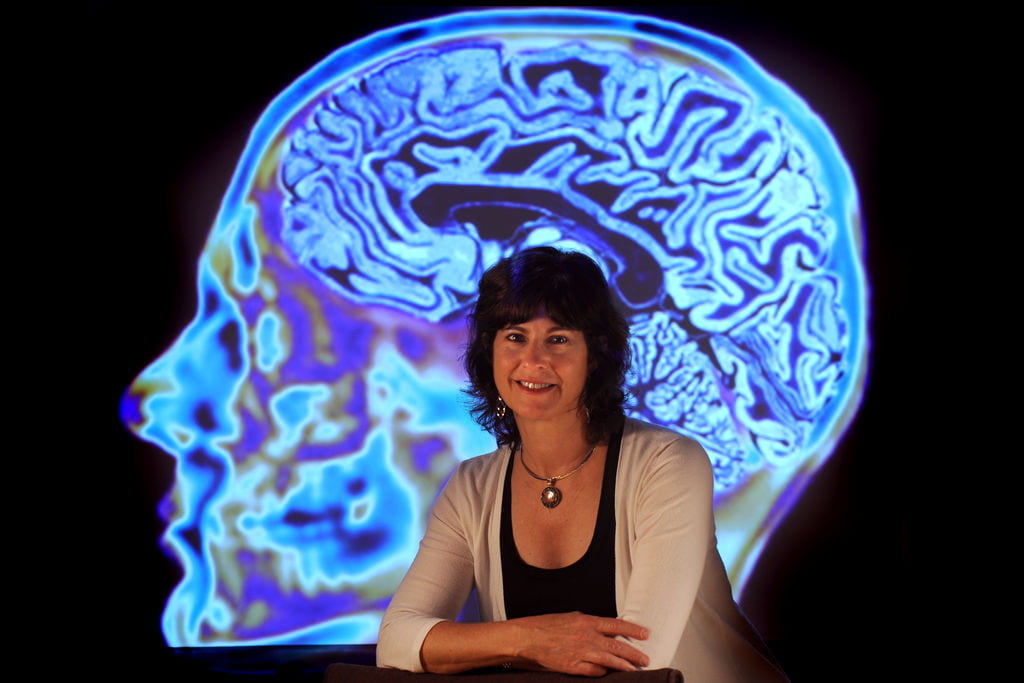Race against the clock

Ask UC Irvine neuroscientist Leslie M. Thompson to describe how Huntington’s disease affects patients, and she replies by turning to her computer. “I can show you,” she says. She clicks on a video of patients she visited in Venezuela. On-screen, a middle-aged man stands on a street corner, swaying as if intoxicated. A woman, no longer able to walk or feed herself, lies dying in her bed.
“That’s the end stage. It’s awful, just awful,” Thompson says, shaking her head. “Huntington’s always ends in death.”
A professor of psychiatry & human behavior and neurobiology & behavior, as well as director of the Interdepartmental Neuroscience Program, Thompson has dedicated the last 20 years of her career to halting Huntington’s — a fatal brain disorder that affects about 30,000 people in the U.S., with another 200,000 at risk of inheriting it. While a postdoctoral researcher at UCI, Thompson helped identify the gene that causes Huntington’s. Now she’s using a powerful new tool to find a cure: stem cells.
“We’re trying to understand how the DNA mutation that causes Huntington’s disease makes brain cells sicken and die,” says Thompson, who received a $1.4 million grant to develop new stem cell lines for Huntington’s with Peter Donovan and Hans Keirstead, co-directors of the Sue & Bill Gross Stem Cell Research Center.
“Stem cells offer us a new way to study the disease by allowing us to derive and examine human neurons carrying the mutation,” she says. “That’s a big step forward. Now we can develop ways to treat the disease and address other genetic factors that cause some people to get Huntington’s earlier than others.”
Her work recently earned her the 2009 Huntington’s Disease Society of America’s Research Award — an honor Thompson shares with colleagues and families who have helped her understand Huntington’s human toll.
“Leslie Thompson has been a catalyst for aggressive research toward finding the cure for Huntington’s,” says Frances Saldaña, manager of the corporate partners program at The Paul Merage School of Business, whose husband died of Huntington’s in 1989. Their three grown children have the disease.
“Leslie’s commitment gives me hope that my grandchildren will never have to worry about inheriting this devastating disease,” Saldaña says. “It’s already too late for my children, who are now in the advanced stages, but Leslie continues to work furiously to beat the clock.”
Saldaña has worked with Thompson to raise awareness about Huntington’s, starting an HDSA Orange County affiliate and organizing the annual Team Hope Walk for the Cure, which takes place Sept. 26 at UCI. Along with Dr. Neal Hermanowicz, director of movement disorders services at UC Irvine Medical Center, they led efforts to open UCI’s Huntington’s Disease Clinic in 2005.
Signs of Huntington’s typically begin in midlife, but the Saldaña children, who are in their 30s, have a form of the disease that strikes early. The eldest, Marie, is receiving hospice care. Michael is in a wheelchair. Margie, the youngest, can no longer look after her two children.
“Huntington’s causes severe cognitive impairment,” Thompson says. “Patients can’t perform daily tasks. They lose their jobs. There’s depression and irritability. Their personalities can totally change. Eventually, they can’t eat and they can’t walk. There’s a general wasting away.
“They usually die of aspiration pneumonia or in falls. There are no treatments that change the course of the disease, no cures. There’s nothing to stop it.”
Those who have watched a parent slowly die of Huntington’s know there’s a 50 percent chance they inherited the gene — and “if you inherit it, you get it — unless you die earlier of other causes,” Thompson says.
“Huntington’s is so devastating for these families. If we could find something to prevent or even delay this disease, it would end a great deal of suffering. I don’t have a timeline, but I do have a lot of hope.”
Originally published in Zotzine Vol. 2, Iss. 1